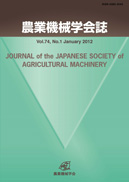All issues

Volume 74, Issue 1
Displaying 1-13 of 13 articles from this issue
- |<
- <
- 1
- >
- >|
ESSAY
-
H. SHIMIZU2012Volume 74Issue 1 Pages 1-2
Published: January 01, 2012
Released on J-STAGE: September 19, 2013
JOURNAL FREE ACCESSDownload PDF (224K)
SPECIAL EDITION
-
T. CHOSA2012Volume 74Issue 1 Pages 3
Published: January 01, 2012
Released on J-STAGE: September 19, 2013
JOURNAL FREE ACCESSDownload PDF (139K) -
Kenji FUKUMIYA, Naotaka HIRAO2012Volume 74Issue 1 Pages 4-8
Published: January 01, 2012
Released on J-STAGE: September 19, 2013
JOURNAL FREE ACCESSDownload PDF (619K) -
Hiroshi SOMA2012Volume 74Issue 1 Pages 9-14
Published: January 01, 2012
Released on J-STAGE: September 19, 2013
JOURNAL FREE ACCESSDownload PDF (535K) -
Takehiko OKUYAMA2012Volume 74Issue 1 Pages 15-19
Published: January 01, 2012
Released on J-STAGE: September 19, 2013
JOURNAL FREE ACCESSDownload PDF (621K) -
Hirotaka SAITO, Shoichiro HAMAMOTO, Toshiko KOMATSU2012Volume 74Issue 1 Pages 20-25
Published: January 01, 2012
Released on J-STAGE: September 19, 2013
JOURNAL FREE ACCESSDownload PDF (581K)
TECHNO-TOPICS
-
K. HAYASHI2012Volume 74Issue 1 Pages 26-28
Published: January 01, 2012
Released on J-STAGE: September 19, 2013
JOURNAL FREE ACCESSDownload PDF (329K)
RESEARCH ACTIVITIES
-
M. MITARAI2012Volume 74Issue 1 Pages 29-30
Published: January 01, 2012
Released on J-STAGE: September 19, 2013
JOURNAL FREE ACCESSDownload PDF (219K)
PAPERS (Articles)
RESEARCH PAPER
-
—Application in a Flowing System for an Unsteady State—Yoshinori KAWAGOE, Itaru SOTOME, Seiichi OSHITA, Yasuhisa SEO2012Volume 74Issue 1 Pages 43-55
Published: January 01, 2012
Released on J-STAGE: September 19, 2013
JOURNAL FREE ACCESSWhen a flowing system using the conventional formula was applied to an unsteady state despite the assumption of a steady state, the occurrence of errors was observed. Because a steady state cannot always be assumed, the application of the flowing system to an unsteady state was considered using the modified formula obtained in a previous study. The range of inflow rate that could be used and the accuracy required for gaseous concentration measurement were determined using the defined outflow concentration range. The onset of measurement was determined using the ratio of quantity of dry gas in a respiratory chamber to the inflow rate. Thus, the flowing system using the modified formula can be applied to an unsteady state.View full abstractDownload PDF (441K)
TECHNICAL PAPERS
-
—Outline of Developed machine, Tests on Use of Chisels and Tests on Travel Speeds—Takashi GOTOH, Tsukasa TESHIMA, Yukito FUJII, Masahiro OHNISHI, Jun EN ...2012Volume 74Issue 1 Pages 56-65
Published: January 01, 2012
Released on J-STAGE: September 19, 2013
JOURNAL FREE ACCESSThe problems of rotary cultivators that are widely used in Japan for inter-row cultivating and earthing up are soil kneading under wet soil conditions and low travel speed. To improve these problems, we have developed disk cultivator-ridgers. With these machines, inter-row soil is turned over laterally by the revolution of the disks and consequently inter-row cultivating and earthing up are performed. The effect of chisels and travel speeds was investigated and the following results were obtained. (1) In fields where disks cold not cultivate sufficiently, earthing up performance was maintained by the use of chisels. (2) The soil pulverizing performance did not become worse at higher travel speeds. (3) The most stable earthing up performance was obtained at travel speeds of 1.0-1.6m/s.View full abstractDownload PDF (511K) -
—Tests on Disk Shape—Takashi GOTOH, Tsukasa TESHIMA, Yukito FUJII, Masahiro OHNISHI, Jun EN ...2012Volume 74Issue 1 Pages 66-71
Published: January 01, 2012
Released on J-STAGE: September 19, 2013
JOURNAL FREE ACCESSThe effect of changing the shape of rear disks on the performance of two prototypes of disk cultivator-ridger was investigated in three fields planted with soybean. The following results were found. (1) Using notched disks as rear disks instead of smooth-edged disks resulted in better soil pulverizing performance under wet soil conditions, since fewer large clods were produced by the scraping of stuck soil on the surface of notched disks. (2) Using convex notched disks as rear disks instead of concave notched disks resulted in better soil pulverizing performance, fewer buried and lodged soybean plants rate. However, convex notched disks tended to compress the soil under wet soil conditions.View full abstractDownload PDF (415K) -
—Tests on Cultivating Depth and Disk Adjustment—Takashi GOTOH, Tsukasa TESHIMA, Yukito FUJII, Masahiro OHNISHI, Jun EN ...2012Volume 74Issue 1 Pages 72-78
Published: January 01, 2012
Released on J-STAGE: September 19, 2013
JOURNAL FREE ACCESSThe effect of the position of gage wheels and disk adjustment on the earthing up performance of two disk cultivator-ridger prototypes was investigated in two fields planted with soybean, in one uncultivated field and three fields planted with soybean respectively. The following results were obtained. (1) There were few differences between front gage wheels and rear gage wheels on earthing up performance. (2) To secure optimal earthing up performance, it was important that the disk angle of the front disks was increased in proportion to the distance between rows, the distance between the rear disks was maintained at 40-45cm regardless of distance between rows, and the disk angle of the rear disks was reduced by 7.5°for every increase of 0.5m/s in travel speed.View full abstractDownload PDF (405K)
SHORT PAPER
-
Takahiro NODA, Yasuyuki HIDAKA, Mio YOKOE, Hiroyuki IYOTA, Tamotsu INO ...2012Volume 74Issue 1 Pages 79-82
Published: January 01, 2012
Released on J-STAGE: September 19, 2013
JOURNAL FREE ACCESSDownload PDF (303K)
- |<
- <
- 1
- >
- >|